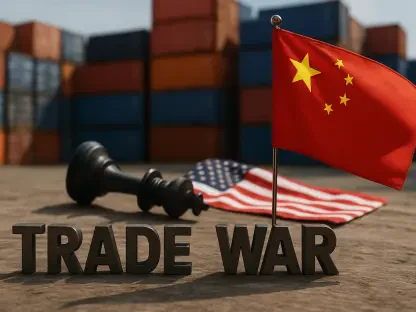Priya Jaiswal is a recognized authority in Banking, Business, and Finance, with extensive expertise in market analysis, portfolio management, and international business trends. Today, she will be offering insights into the OECD’s recent revisions of global economic growth forecasts, particularly in the context of President Donald Trump’s aggressive trade policies.
How have President Trump’s trade policies influenced the OECD’s economic growth outlook?
President Trump’s trade policies have created significant uncertainty and disrupted global trade flows. The OECD has lowered its growth forecasts for many countries, predicting that global expansion will slow due to these heightened barriers to commerce, leading to reduced business investment and consumer spending.
Can you elaborate on the historical significance of these growth rate reductions for the US and other affected countries?
Historically, such reductions in growth rates indicate a significant disruption in economic activities. For the US, this would be the weakest growth since 2011, aside from the initial shock of the COVID-19 pandemic in 2020. Mexico faces a severe contraction, while Canada’s projected growth slows considerably, reflective of the broader impact of tariff hikes and trade tensions.
How does the revised forecast for US growth in 2025 and 2026 compare to previous years?
The forecast for US growth in 2025 has been reduced to 2.2 percent, down from an earlier estimate of 2.4 percent. For 2026, growth is projected at 1.6 percent, a significant drop from the previous 2.1 percent forecast, indicating a notable slowdown.
What specific impacts are anticipated for Mexico’s economy?
Mexico is expected to be one of the hardest-hit economies, with its growth forecast now predicting contractions of 1.3 percent in 2025 and 0.6 percent in 2026, compared to previous expectations of growth.
How does the outlook for Canada’s growth differ from previous forecasts?
Canada’s growth rate forecasts have been significantly downgraded to 0.7 percent for both 2025 and 2026, a sharp decline from the 2 percent forecasted earlier, making it evident that trade tensions heavily impact the Canadian economy.
How are European economies being affected by the current trade tensions?
European economies are currently less directly affected by the trade wars, but increased uncertainty and reduced business confidence have led to revised downwards growth forecasts.
What factors are influencing the revised growth forecasts for Europe?
Factors include the general atmosphere of uncertainty around global trade policies, which affects business investment and consumer spending, and the possibility of secondary effects from the US-China trade tensions.
What is the expected impact on global inflation due to heightened trade barriers?
The increased costs of commerce due to trade barriers are expected to fuel stronger inflation globally. This will likely result in central banks having to maintain more restrictive policies for longer periods.
How will central banks’ policies need to adjust to manage inflation?
Central banks may need to adopt tighter monetary policies to curb rising inflation, which could involve increasing interest rates and other measures to control price stability.
Can you describe the methodology the OECD used to assess the damage from trade wars?
The OECD used various economic models to simulate the impact of current and potential future tariffs. They considered both implemented measures and possible escalations in trade barriers.
What assumptions did the OECD make in their analysis?
The OECD assumed that existing tariffs would remain and additional tariffs, particularly between the US and its trading partners, would be imposed, along with likely retaliatory measures.
How do these assumptions impact the reliability of their forecasts?
These assumptions create a scenario-based forecast, which can be valuable but also carries inherent uncertainty, as actual trade policy changes and their economic impacts can deviate from predictions.
What are some potential risks associated with the “disruptive repricing” in financial markets mentioned by the OECD?
Disruptive repricing could lead to increased market volatility, sudden shifts in asset valuations, and potential financial instability as investors react to the uncertain trade environment.
How might central banks respond to mitigate these risks?
Central banks might employ measures such as adjusting interest rates, providing liquidity support, and closely monitoring financial markets to maintain stability.
What specific tariffs and measures have already been implemented between the US and China?
The US has imposed broad-based 25 percent tariffs on steel and aluminum imports and additional tariffs on a wide range of Chinese goods.
How are these tariffs expected to evolve moving forward?
There is potential for these tariffs to increase or for new tariffs to be introduced, particularly if the trade tensions escalate further.
What other threats has President Trump made regarding global trade, and how might they affect the global economy?
President Trump has threatened global reciprocal tariffs and specific sectoral levies, which could further strain international trade relations and negatively impact global economic stability.
The OECD conducted illustrative simulations of global output based on raised tariffs. Can you explain these findings?
The simulations suggested that if bilateral tariffs were permanently raised by 10 percentage points, global output could decline by about 0.3 percent by the third year, with the US experiencing a 0.7 percent reduction in output.
What are the projected impacts on global output in these scenarios?
Global output is expected to fall due to increased costs and decreased trade efficiency, leading to lower economic growth worldwide.
How would US output be specifically affected?
The US is anticipated to see a significant hit, with a projected 0.7 percent decline in output under raised tariff scenarios.
What long-term impacts could trade tensions and tariffs have on business investment and consumer spending?
Prolonged trade tensions and tariffs could lead to sustained uncertainty, reducing business investment and consumer spending, which are critical drivers of economic growth.
Despite the gloomy outlook, are there any potential upside risks mentioned by the OECD?
Yes, if tariffs are lowered and policies become more stable, there could be positive economic outcomes. Additionally, increased defense spending could provide economic support, albeit with financial pressures.
How could defense spending influence the economic outlook?
Higher defense spending could stimulate economic activity and potentially offset some negative impacts of trade tensions, though it would strain government budgets.
What measures should countries take to maintain well-functioning global markets and a rules-based trading system?
Countries should work towards reducing trade barriers, adhering to international trade agreements, and collaborating to ensure a fair and predictable global trading environment.
What advice does the OECD have for policymakers to counter the negative effects of trade tensions and ensure economic stability?
The OECD recommends maintaining open trade policies, engaging in international cooperation, and using fiscal and monetary tools to support the economy and mitigate adverse effects.
How are investors reacting to the ongoing trade tensions and economic uncertainty?
Investors are cautious, leading to market volatility and adjustments in asset allocations as they try to navigate the uncertain trade environment.
What insights did OECD Secretary-General Mathias Cormann provide regarding future trade decisions and their potential impacts?
Mathias Cormann pointed to significant downside risks from further trade fragmentation and emphasized the need for stable policies to avoid long-term economic damage.
How does the OECD’s analysis compare with other international organizations’ assessments of global trade tensions?
The OECD’s analysis is in line with other international organizations like the IMF, emphasizing the adverse impacts of trade tensions on global growth and economic stability.
How might global trade relations evolve if trade wars continue to escalate?
Escalating trade wars could lead to more protectionism, reduced international cooperation, and fragmented global markets, potentially causing long-term harm to economic growth.
What is your forecast for global trade relations if the current tensions persist?
If current tensions persist, we might see prolonged periods of uncertainty and slower global economic growth, with countries increasingly turning to protectionist policies, harming both individual economies and the global trade system.









